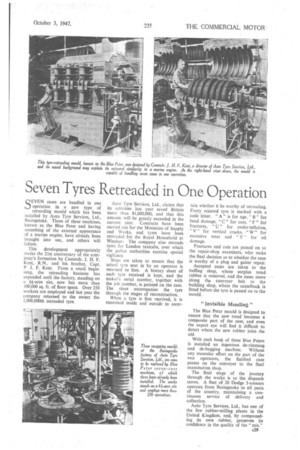Seven Tyres Retreaded in One Operation
Page 31

If you've noticed an error in this article please click here to report it so we can fix it.
SEVEN cases are handled in one operation in a new type of retreading mould which has been installed by Auto Tyre Services, Ltd., Basingstoke. Three of these machines, known as the Blue Peter and having something of the external appearance of a marine engine, have already been brought into use, and others will follow.
This development appropriately marks the 21st anniversary of the company's formation by Commdr. J. H. F. Kent, R.N., and his brother, Capt. P J. F. Kent. From a small beginning, the retreading business has expanded until the factory, standing on a 6k-acre site, now has more than 100,000 sq. ft. of floor space. Over 250 workers are employed and last year the company returned to the owner the 2,000,000th retreaded tyre. Auto -Eyre Services, Ltd., claims that its activities last year saved Britain more than $1,000,000, and that this amount will be greatly exceeded in the current year. Contracts have been carried Out for the Ministries of Supply and Works, and tyres have been retreaded for the Royal Household at Windsor. The company also retreads tyrcs for London taxicabs, over which the police authorities exercise special vigilance.
Steps are taken to ensure that the actual tyre sent in by an operator is returned to him. A history sheet of each tyre received is kept, and the maker's serial number, together with the job number, is painted on the case. The sheet accompanies the tyre through the stages of reconstruction.
When a tyre is first received, it is examined inside and outside to ascer tam n whether it be worthy of retreading. Every rejected tyre is marked with a code letter. " A " is for age, " B " for bead damage, "C" for cuts, " F " for fractures, " U " for under-inflation, "
V" for vertical cracks, " W " for excessive wear and " Y for oil damage.
Fractures and cuts are passed on to the repair-shop examiners, who make the final decision as to whether the case is worthy of a plug and gaiter repair.
Accepted cases are taken to the bulling shop, where surplus tread rubber is removed, and the cases move along the conveyer belt to the building shop, where the camelbaek is fitted before the tyre is passed on to the mould.
"Invisible Mending"
The Blue Peter mould is designed to ensure that the new tread becomes a composite part of the case, and even the expert eye will find it difficult to detect where the new rubber joins the old.
With each bank of three Blue Peters is installed an ingenious de-rimming and de-bagging machine. Without any muscular effort on the part of the two operators, the finished case passes on the conveyer to the final examination shop.
The final stage of the journey through the works is to the dispatch stores. A fleet of 20 Dodge 3-tanners operates from Basingstoke to all parts of the country, maintaining a continuous service of delivery and collection.
Auto Tyre Services, Ltd. has one of the few rubber-milling plants in the United Kingdom, and, by compounding. its own rubber, preserves its confidence in the quality of the "mix."




















































































